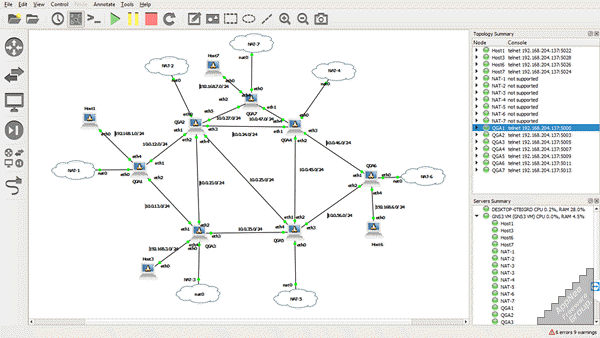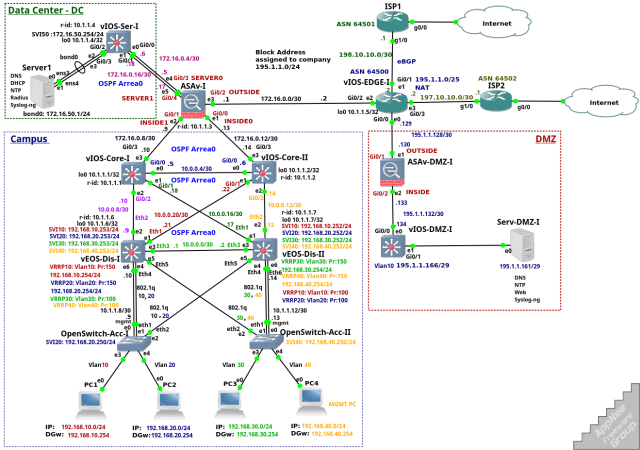| Ⅰ | This article along with all titles and tags are the original content of AppNee. All rights reserved. To repost or reproduce, you must add an explicit footnote along with the URL to this article! |
| Ⅱ | Any manual or automated whole-website collecting/crawling behaviors are strictly prohibited. |
| Ⅲ | Any resources shared on AppNee are limited to personal study and research only, any form of commercial behaviors are strictly prohibited. Otherwise, you may receive a variety of copyright complaints and have to deal with them by yourself. |
| Ⅳ | Before using (especially downloading) any resources shared by AppNee, please first go to read our F.A.Q. page more or less. Otherwise, please bear all the consequences by yourself. |
| This work is licensed under a Creative Commons Attribution-NonCommercial-ShareAlike 4.0 International License. |

GNS3 (short for Graphical Network Simulator-3) is a cutting-edge and feature-rich network simulation platform for Windows, Mac and Linux platforms, developed by SolarWinds from Canada in 2008. It allows users to create virtual network environments and test various network configurations with ease.
By leveraging virtualization technologies, GNS3 allows users to create virtual networks that closely resemble real-world network setups. With it, users can design complex network topologies (such as a complete simulation of the entire campus network or enterprise network) using virtual routers, switches, and other network devices. It provides a realistic environment for network testing and troubleshooting, making it an essential tool for network engineers and IT professionals. So, it is widely used in the networking industry for designing, testing, and troubleshooting network configurations.
To put it simply, GNS3 is actually a GUI front-end for Dynamips, which is easier and more efficient than using Dynamips directly. It integrates Dynamips, Dynagen, PEMU, WinPcap, QEMU, Wireshark and other software, aiming to provide Win32 applications with the ability to access the bottom layer of the network. GNS3 supports multiple network vendors, including Cisco, Juniper, and MikroTik, allowing users to work with different network devices. Its friendly graphical user interface simplifies the process of creating and managing virtual networks. It also offers advanced features such as packet capture and analysis, network monitoring, and integration with external tools.
Among so many network simulators, GNS3 is currently the most complete one with the best user experience, and it is free and open-source. Since GNS3 simulates network equipment such as routers and switches, it needs to call a network operating system image such as Cisco IOS. And it calls a real network operating system, so when we build a simulation environment through GNS3, the commands and output content are no different from the real machine. In contrast, other network simulators often experience commands that are not supported or debugging failures.
Overall, GNS3 is a versatile and powerful tool that empowers network professionals to build and test complex network setups with ease. Cisco network equipment administrators or people who want to pass Cisco certification exams (such as CCNA, CCNP, CCIE, etc.) can use it to complete relevant experimental simulation operations. At the same time, it can also be used to virtually experience Cisco Internet Operating System (IOS) or to verify the related configurations that will be deployed on real routers.

// Key Features //
- Real time network simulation without the need for network hardware
- Test more than 20 different network vendors
- Connect your GNS3 topologies to your existing hardware
- Enables troubleshooting and proof of concept (POC) testing
// Related Links //
// Download URLs //
| License | Version | Download | Size |
| Freeware | Latest |  (mir1 | mir2) (mir1 | mir2) |
n/a |
(Homepage | GitHub | SourceForge)
| If some download link is missing, and you do need it, just please send an email (along with post link and missing link) to remind us to reupload the missing file for you. And, give us some time to respond. | |
| If there is a password for an archive, it should be "appnee.com". | |
| Most of the reserved downloads (including the 32-bit version) can be requested to reupload via email. |